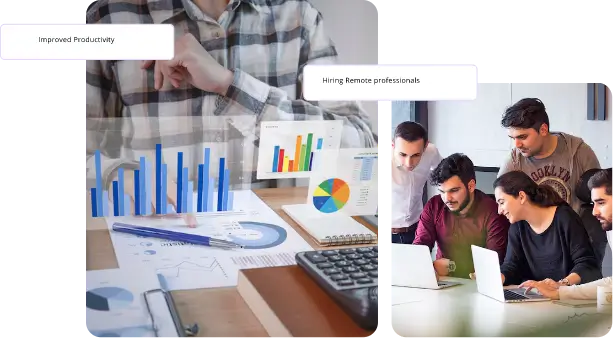Hire to Retire: Meaning, Components, Process & Benefits
The "hire to retire" process begins when a person is hired and continues until they leave the organization. It encompasses everything in that person's journey: recruiting, onboarding, training, promotions, and leaving, whether retirement or resignation. When companies are effective in managing their "hire to retire" process, it guides effective employee experience through responding to employee needs and aiding their development. Effective hire-to-retire processes bedeck cheerful, engaged employees while also enabling the company to grow and prosper.
There are benefits to both the employee and the employer when there is a positive hire-to-retire system for an employee. An employee is aware of the responsibilities of their role, the development opportunities, and where the policies of the organization lie, while an employer benefits through decreased turnover, higher productivity, and a stronger reputation. If companies truly pay attention to each stage of the employee journey, they have a greater chance of developing positive relationships between the employee and employer while staying competitive in the innovation landscape.
What is the Hire to Retire?
The hire-to-retire process refers to the entire life cycle of an employee in your company, starting at hire and ending with retirement (or separation), and all the steps that fall in between.
The goal of hire-to-retire is to provide a consistent and positive experience for employees. It begins when someone is hired, stays with them through their training and career landscapes, supporting and transitioning them through until they leave. It allows both new and existing team members to share the same expectations at certain points in their journeys.
A strong hire-to-retire process will ensure your organization brings in the right talent, and that the talent feels supported, encouraged, and valued through all pathways to employment. It creates a feeling of belonging and trust found in happiness and motivation within each employee's work.
By investing in the hire-to-retire journey, organizations can deliver real benefits, collaborative abilities, transitions from one employee to another, and a capable and participative workforce throughout the employee's life cycle and while growing with the organization.
What are the key components of the Hire to Retire process?
-
Recruiting
Identifying and attracting candidates will be the first step. Hiring can include job boards, interview candidates, and identifying the best candidates for the organization.
-
Onboarding
When an employee is hired, they receive an orientation, training, and preparation for the organization's policies, their job responsibilities, and tools and resources to be successful.
-
Development
Development is the continuous training, skills, and opportunities for advancement to another position or promotion. It keeps the employee engaged, meeting the ever-changing demands of the business, and connected to their current position.
-
Performance Management
The manager sets clear expectations for employees and completes ongoing feedback and evaluations to help the employee develop and grow their career.
-
Compensation and Benefits
Fair wages, bonuses, health benefits, and other benefits can leave employees feeling appreciated for their efforts.
-
Separation/Retirement
When an employee leaves, the ongoing process of separation will maintain consistency in communicating with each separation. A business will rarely lose an employee's knowledge and experience, knowledge transfer, knowledge retention, and retirement planning knowledge.
What are the Stages of the Hire-to-Retire Process?
1. Recruitment and Hiring
Employers are interested in hiring new employees. Most employers initiate the interview and offer process by contacting the people they wish to employ as potential employees.
2. Onboarding
New hires attend orientation to learn about the organization and their new coworkers. Furthermore, the organization should guide and provide the new employee with resources for getting started.
3. Career Development
During career development, the employee may be involved in training and development activities, coaching, a transfer of some sort, or even a promotion as part of their career development process.
4. Performance Reviews
In many organizations, regularly scheduled check-ins provide employees the opportunity to reflect on past measures of performance, set new performance goals and celebrate achievements.
5. Offboarding and Retirement
Regardless of how an employee leaves the organization (retirement, layoff, etc.), you provide a thorough and thoughtful offboarding process by ensuring a knowledge transfer occurs and the relationship ends positively.
What are the Benefits of a Hire-to-Retire Approach?
1. Streamlines Employee Lifecycle: The hire-to-retire approach connects every step of the employee journey, from hiring to retirement, as part of a singular unified process. It provides smooth transitions for employees and consistent experiences.
2. Improves Talent Management: With all employee data in one system, it's easier to track performance, skills, and career growth. This provides managers with greater insight into employee benefits, determining promotions, purposes, training, and development.
3. Better Workforce Planning: This approach gives a full view of workforce trends, helping HR plan ahead for hiring needs, retirements, and role changes based on accurate data.
4. Enhances Employee Experience: Employees benefit from clear communication, consistent support, and well-managed HR services. This creates a positive work environment and stronger engagement.
5. Increases Efficiency and Accuracy: Automated processes will decrease manual work and input errors around payroll, benefits, and leave tracking; therefore, you will be able to save time and be accurate.
6. Stronger Compliance and Record-Keeping: A hire-to-retire system provides an active and organized employment record, while demonstrating compliance with the law by providing a cleaner audit process.
What Is the Role of Technology in the Hire-to-retire (HTR) Process?
Technology makes everything about speed and ease. It has systems to onboard new employees and systems to put candidates in place quickly, as performance management systems for conducting performance reviews, and payroll or benefits systems to accurately and completely administer the employee's pay. It has come to the point where only exit interviews might be done, which allows for processing the transition of a former employee with technology as well.
When organizations take advantage of the use of such technologies, the employees and the employer have more time to spend in person with people than working with papers. This will only create a good hire-to-retire experience for everyone involved. Analytics that can be made available to HR teams can create their analytic mindsets even if they are only looking at reports that might show gaps, nearness to a resignation, and some of which in a subsequent step in planning steps to take.
In the end, the technology does increase speed, accuracy, and transparency related to all aspects of the HTR journey, and it reduces friction for employees, but also for employers as well.

